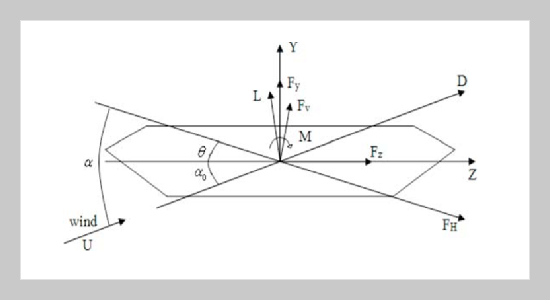REFERENCES
- [1] Hirai, A., Okauchi, I. and Ito, M., “Studies on the Critical Wind Velocity for Suspension Bridges,” Proc. Int. Res. Seminar on Wind Effects on Buildings and Structures, Ontario: University of Toronto Press, Canada, pp. 81103 (1967).
- [2] Xiang, H. F. and Lin, Z. X., “Bridge Wind Load Design Specification,” Research Topics, Structural Engineer, Vol. 11, pp. 14 (1998). [Chinese]
- [3] Boonyapinyo, V., Miyata, T. and Yamada, H., “Analysis of Cable-Supported Bridges under Wind Load, Part I: Ultimate Strength,” Proceedings of the Fourth Asia Pacific Symposium on Wind Engineering, Australia (1997).
- [4] Boonyapinyo, V., Miyata, T. and Yamada, H., “Analysis of Cable-Supported Bridges under Wind Load, Part II: Combined Flutter and Buffeting Response in Time Domain,” Proceedings of the Fourth Asia Pacific Symposium on Wind Engineering, Australia (1997).
- [5] Boonyapinyo, V., Yamada, H. and Miyata, T., “WindInduced Nonlinear Lateral-Torsion Buckling of Cable-Stayed Bridges,” Journal of Structural Engineering, Vol. 120, No. 2, pp. 486506 (1994). doi: 10. 1061/(ASCE)0733-9445(1994)120:2(486)
- [6] Miyata, T. and Tanaka, H., Wind Effects on Structures: “Aerodynamics of Long-Span Structures,” Univ. of Tokyo Press (1976).
- [7] Miyata, T., Yamada, H. and Kazama, K., “On an Application of the Direct Flutter FEM Analysis for Long-Span Bridges,” Proc. 9th Int. Conf. on Wind Engineering, New Delhi, India, pp. 10331041 (1995).
- [8] Boonyapinyo, V., Yamada, H. and Lvflyata, T., “Wind Induced Nonlinear Lateral-Torsional Buckling of Cable-Stayed Bridges,” Structural Engineering, ASCE (1994). doi: 10.1061/(ASCE)0733-9445(1994)120:2 (486)
- [9] Hirai, A., Okauchi, I. and Ito, M., “Studies on the Critical Wind Velocity for Suspension Bridges,” Proc. Int. Res. Seminar on Wind Effects on Buildings and Structures, Ontario: University of Toronto Press, Canada, pp. 81103 (1967).
- [10] Nagai, M., Xie, X., Yamaguchi, H. and Fujino, Y., “Static and Dynamic Instability Analyses of 1400- Meter Long-Span Cable-Stayed Bridges,” Long-Span and High-Rise Structures, IABSE Symposium, Kobe, pp. 281286 (1998).
- [11] Boonyapinyo, V., Miyata, T. and Yamada, H., “Analysis of Cable-Supported Bridges under Wind Load, Part I: Ultimate Strength,” Proceedings of the Fourth Asia Pacific Symposium on Wind Engineering, Australia (1997).
- [12] Boonyapinyo, V., Miyata, T. and Yamada, H., “Analysis of Cable-Supported Bridges under Wind Load, Part II: Combined Flutter and Buffeting Response in Time Domain,” Proceedings of the Fourth Asia Pacific Symposium on Wind Engineering, Australia (1997).
- [13] Miyata, T., Yamada, H. and Kazama, K., “On Application of the Direct Flutter FEM Analysis for Long Span Bridges,” Proc. 9th Int. Conf. on Wind Engineering, New Delhi, India, Vol. 2, pp. 10331041 (1995).
- [14] Xie, X. and Yamaguchi, H., “Static Behaviors of SelfAnchored and Partially Earth-Anchored Long Span Cable Stayed Bridges,” Structural Engineering and Mechanics, Vol. 6, No. 5, pp. 767774 (1997). doi: 10.12989/sem.1997.5.6.767
- [15] Fang, M. S., Large-Span Cable Supported Bridge Nonlinear Aerostatic Stability Theory, PhD Thesis, Tongji University (1997). [Chinese]
- [16] Cheng, J., Study on Nonlinear Aerostatic Stabifity of Cable-Supported Bridges, PhD Thesis, Tongji University (2000). [Chinese]
- [17] Zhang, Z. T., Nonlinear Buffeting Vibration and It’s Effects on Aerostatic and Aerodynamic StabiIity of Long-Span Bridges, PhD Thesis, Tongji University (2004). [Chinese]
- [18] Zou, X. J., Domain Analysis of Cable Stayed Bridge Wind-Induced Vibration Response and Stability of the Static Wind, PhD Thesis, South China University of Technology (2003). [Chinese]
- [19] Nagai, M., Fujino, Y., Yamaguchi, H. and Iwasaki, E., “Feasibility of a 1,400 m Span Steel Cable-Stayed Bridge,” J. Bridge Eng., Vol. 9, No. 5, pp. 444452 (2004). doi: 10.1061/(ASCE)1084-0702(2004)9:5(444)
- [20] Hu, X. L., Stability Analysis of Large Span CableStayed Bridge Shaking Vibration Response and Calm Wind, PhD Thesis, Tongji University (2006). [Chinese]
- [21] JTG/T D60-01-2004, Highway Bridge Wind Load Design Specification, Beijing: China Communications Press (2004). [Chinese]









